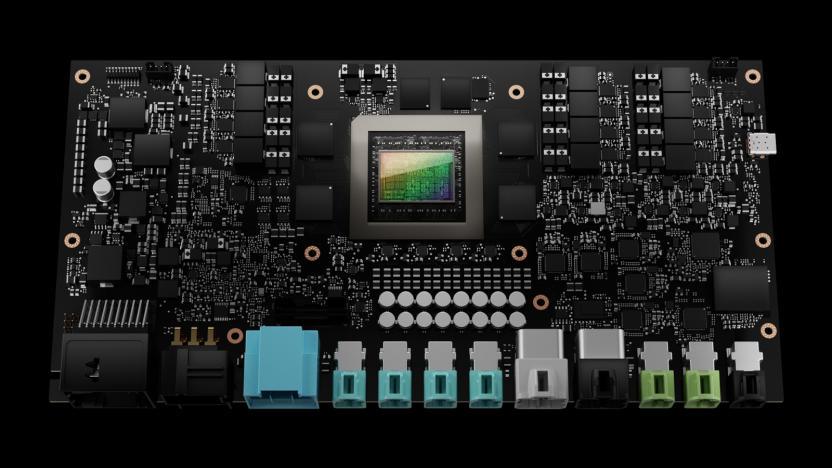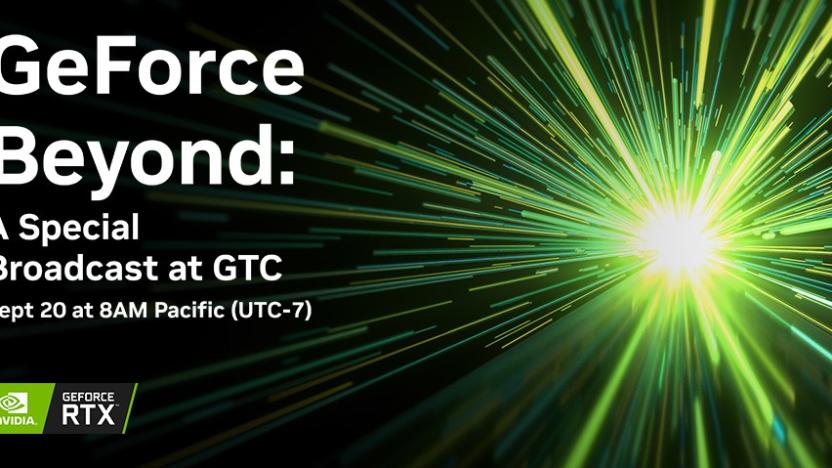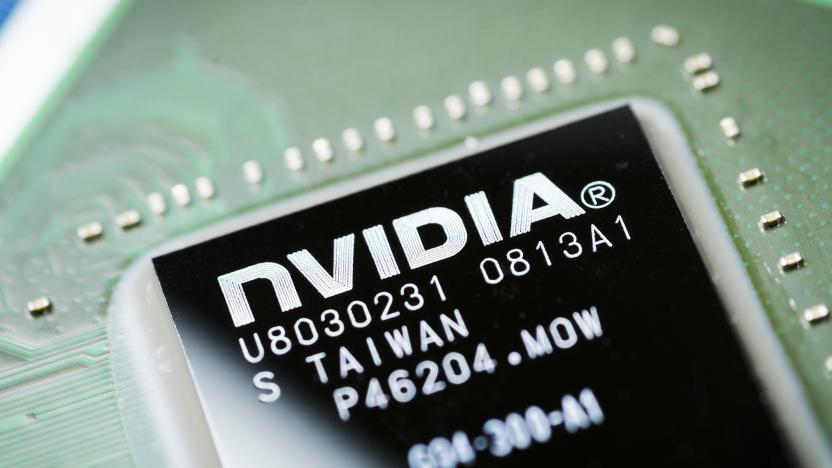gtc
Latest

NVIDIA's new AI model quickly generates objects and characters for virtual worlds
GET3D could make it easier for developers to make games and VR experiences.

NVIDIA reveals its next-gen chipset for autonomous vehicles
The Drive Thor SoC will first appear in 2025 models.

NVIDIA looks set to reveal its next-gen GeForce RTX GPUs on September 20th
The company has announced a GeForce Beyond broadcast at GTC 2022.

NVIDIA's more powerful 'AI brain' for robots is available now for $1,999
NVIDIA is now selling its upgraded AI brain for robots, the Jetson AGX Orin, as a $1,999 developer kit.

Watch NVIDIA's GTC 2021 keynote here at 11:30AM ET
NVIDIA is holding its GTC keynote at 11:30AM ET, and it's poised to share news on graphics, self-driving car technology and more.

NVIDIA's GPU Technology Conference goes online in October
CEO Jensen Huang will kick things off with a keynote.

NVIDIA focuses on AI in the internet and for industries
NVIDIA's graphics technology is useful for a lot more than just lining up pixels on gamer's monitors, and in a presentation at the GPU Technology Conference, CEO Jensen Huang revealed a few more layers of its plans. The Jetson AGX Xavier platform unveiled earlier this year for autonomy is rolling out, and now developers can order a Drive AGX Xavier devkit to test software for self-driving vehicles. Speaking of AGX, NVIDIA announced that several Japanese companies (FANUC, Komatsu, Musashi Seimitsu and Kawada Technologies) will integrate the Jetson technology into their autonomous robots.

Watch the highlights of NVIDIA's GPU Technology Conference keynote
Under NVIDIA founder Jensen Huang's iconic leather jacket is one of the tech industry's sharpest CEOs -- a man who can not only talk eloquently about GPU architecture, machine learning and the limits of Moore's Law, but do so for hours without a strict script. It's an impressive feat, but if you're not well versed in the technology of server GPUs, his talks can be a little hard to digest. That's why we cut Huang's two hour GTC keynote into an easily digestible clipshow.

NVIDIA's first Volta-powered GPU sits in a $149k supercomputer
If you've been waiting for NVIDIA to finally take the lid off of Volta, the next generation of its GPU technology, your day has finally come. Today at its GPU Technology Conference, the company announced the NVIDIA Tesla V100 data center GPU, the first processor to use its seventh-generation architecture. Like the Tesla P100 the processor it's replacing, the Volta-powered GPU is designed specifically to power artificial intelligence and deep learning so, naturally, it's flush with power. Built on a 12nm process, the V100 boasts 5,120 CUDA Cores, 16GB of HBM2 memory, an updated NVLink 2.0 interface and is capable of a staggering 15 teraflops of computational power. It's also the GPU that drives the company's updated DGX-1 supercomputer, too.

Toyota taps NVIDIA Drive PX to power its autonomous vehicles
The work we've seen Google and Uber put into self-driving cars is impressive, but short of Tesla's autopilot mode, consumer applications of autonomous driving are few and far between. Soon, that could change. Speaking at NVIDIA's GPU Technology Conference, company CEO and Founder Jensen Huang announced that Toyota has chosen the NVIDIA Drive PX platform as the heart of it future autonomous vehicles.

Lenovo's smart TV system grants more processing power and memory through swappable modules (hands-on)
Lenovo is best known for its ThinkPad laptops and newly acquired phone business, but the Chinese firm started making TVs a couple years ago, too. And now, it's the first one to build a set utilizing NVIDIA's new Tegra K1 chip. It's that super-powered silicon that explains the TV's presence at GTC 2014, so naturally, we had to spend some time with it while we were at the show. Called the Terminator S9, it's a 50-inch 4K smart TV that runs a Lenovo-skinned version of Android 4.2 natively, but the real magic happens courtesy of a small plug-in module round the back called a Smart Card.

NVIDIA Shield gets temporary price drop, soon to support remote PC gaming
The GameStream technology that powers the NVIDIA Shield's PC streaming feature is neat, but it has its limitations. Games can only be streamed from desktop PCs running specific GPUs, and only to devices connected to a local network. That's about to change: Pending an update in early April, Shield owners will be able to stream their PC games not only from GeForce GTX-equipped laptops, but over the internet as well. Remote streaming has its own limitations, of course -- NVIDIA recommends a minimum upload/download speed of 5 Mbps -- but the new GameStream beta will let gamers remotely wake up, log in to and play games from their home PC from any location with a stable WiFi connection. NVIDIA is also making it a little easier to stream unofficially supported PC titles, and will update its GeForce Experience desktop software with tools that will push any PC application to the Shield's GameStream list. The spring update also adds Bluetooth keyboard and mouse support, as well as several tweaks to the Shield UI. Specifically, the TegraZone store will be getting categories (action, adventure, etc.) as well as a news section. Finally, NVIDIA will be selling the handheld at a $50 discount from now until the end of April. Already have one? Sit tight -- that update goes live on April 2nd.

NVIDIA announces Titan Z: a $3,000 graphics computing powerhouse
Thought that NVIDIA's Titan Black was as good as it gets in the GPU world? You were mistaken. Meet the GeForce GTX Titan Z (seen in all its glory after the break), NVIDIA's latest graphical behemoth announced by CEO Jen-Hsun Huang today at NVIDIA's 2014 GPU Technology Conference. The Z packs dual Kepler GPUs specifically designed to operate in perfect power and performance harmony. It also keeps cutting-edge games (like those using Unreal Engine 4) running smoothly at up to 5K resolution and on multiple monitors thanks to 12GB of dedicated memory. For now, other Titan Z details are scarce, but we know it costs $3,000, and Huang likens its performance to that of a supercomputer -- what more do you really need to know?

NVIDIA's next-generation GPU is called Pascal, and it's smaller, faster and more efficient
What comes after Fermi, Kepler and Maxwell? Pascal, according to NVIDIA CEO Jen-Hsun Huang. That's the name of the company's next-generation GPU, and Huang says it'll be smaller, faster and more efficient, naturally. "As we compute more, we have to move more data around," he said, speaking at NVIDIA's GPU technology conference in San Jose today. "It's the data bottleneck." He's talking about how the speed at which data is exchanged between the CPU and GPU limits the processor's ability to perform. He's also talking about how NVIDIA hopes to solve the issue, introducing NVLink, a chip-to-chip communication technology (a new socket) that promises to outpace PCIe communication speeds by a factor of five (but up to 12). The company says the PCIe standard probably isn't going away, but is confident that its dedicated GPU socket will allow it to leapfrog existing bottlenecks. Although NVLink seems to be designed to speed up GPU and CPU communication, Huang says it also improves data transfer between GPUs -- meaning that graphics cards linked in SLI could see a performance boost, too.

Massively unboxes EVE Online's Collector's Edition
Sci-fi MMO EVE Online initially launched as a physical disc sold in stores back in 2003 and saw limited success in the fledgling MMO space. A decade of regular updates and digital distribution has seen EVE grow organically into the largest sci-fi sandbox on the planet with over half a million subscribers, but until now something has been missing: EVE has never had an actual collector's edition box. To celebrate 10 successful years of operation, last month CCP officially released the EVE Second Decade Collector's Edition box. I recently received a review copy of the Collector's Edition from CCP and have put together an unboxing video with my general impressions of the items within. The collection comes in a sturdy presentation box and contains a 192-page commemorative hardback book looking back on the first decade of EVE's history, along with an anniversary re-release edition of CCP's board game Danger Game and a physical Rifter model that doubles as a USB hub. The pack also comes with a new account key with 60 days of game time, a soundtrack CD of the EVE music played by the Icelandic Symphony Orchestra, and keys to unlock billions of ISK worth of virtual collectables in-game. It's pretty expensive at around €150 or $150 US, but the virtual items can be sold in game to claw back some of the cost in the form of PLEX. Enjoy our look at the new CE!

NVIDIA CEO Jen-Hsun Huang announces cloud-based, virtualized Kepler GPU technology and GeForce GRID gaming platform
We're here at NVIDIA's GPU technology conference here in San Jose, California and CEO Jen-Hsun Huang just let loose that his company plans to put Kepler in the cloud. To make it happen, the company has created a virtualized Kepler GPU tech, called VGX, so that no physical connections are needed to render and stream graphics to remote locations. So, as Citrix brought CPU virtualization to put your work desktop on the device of your choosing, NVIDIA has put the power of Kepler into everything from iPads to netbooks and mobile phones. While the virtualized GPU has application in an enterprise setting, it also, naturally, can put some serious gaming power in the cloud, too. Fear not, for Jen-Hsun's crew has created GeForce GRID technology that leverages Kepler's cloud capabilities to augment online gaming services like Gaikai by greatly reducing input latency by up to 30ms. Naturally, NVIDIA's not spilling the secret sauce that makes it happen, but you can read all about the new technology at the PR and source below. Sean Buckley contributed to this post.

Fallen Earth's May State of the Game letter showcases new Foothills PvP zone
Roamers of Fallen Earth's post-apocalyptic Grand Canyon province have long been awaiting the final release of the game's Global Territory Control update. Thankfully, the wait is almost over. But meanwhile, today's GamersFirst dev blog post aims to shed some light on some of the latest additions to the system. The spotlight of the post is set on the new PvP conflict area known as The Foothills. The zone is an abandoned settlement situated between Los Alamos and Citadel that "never quite made it." As a result, the various factions of Fallen Earth have taken to fighting for control of the area in order to further solidify their foothold in the region. The Global Territory Control patch is set to go live next Wednesday, so keep an eye on the official dev blog for more details as the update gets closer to launch.

Fallen Earth's March state of the game gets territorial
Another month is upon us, and Fallen Earth is bringing some changes to its Global Territory Control system. While players wait with bated breath for the new features to hit the PTS at the end of the month, GamersFirst has put out a new blog post outlining what players can expect from the next round of updates. We've covered the basics of Global Territory Control previously, so if you want to get up to speed, go on and have a read. Don't worry; we'll wait. Caught up? Good. So what's new this month? The buffs granted by controlling territories have been changed. Now, each town and keep is worth a given number of points. The faction that has the most points will receive a buff that "improves crafting and harvesting speed as well as Random AP, Death Toll, Faction, and Experience gains." Meanwhile, the faction system is getting a revamp that "will see the elimination of shoulder factions." Completing tasks for your faction of choice "will only affect the specific faction you completed it for and its opposite on the faction wheel." This really only scratches the surface of the myriad changes coming to Fallen Earth, so to get the full details just head on over to the game's official site.

Fallen Earth's Global Territory Control creates a singular faction to rule them all
The GamersFirst crew is back with a closer look at one of the exciting PvP features that's being created for Fallen Earth: Global Territory Control. The idea behind GTC is that the devs wanted a comprehensive system that would track faction dominance in PvP across the entire game world. Global Territory Control takes in data from Conflict Towns, Faction Control Points, and open PvP areas, crunches the stats, and spits out a single point rating that shows how well (or forehead-slappingly bad) each of the game's six factions is doing. The new system will go into place for the entire game except for Sector 1, and you'll have to be level-appropriate for the zone to contribute to your faction's GTC score. If a faction earns enough points, then an insanely nice buff is handed out as a reward -- but only one faction can have it at any time. The buff increases the speed of crafting and harvesting and also improves the gain of random AP, Death Toll, faction points, and XP. This system is still being prepped for a future update.

EVE Online players raise over $44,000 for Japan relief fund
Never let it be said that gamers don't have big hearts. When Japan was hit by an earthquake and the ensuing tsunami, people around the world stepped up to donate to disaster relief programs. Several MMO developers have made substantial donations using profits from their games. NCSoft made a huge donation of 500 million yen (6.3 million USD), and Sony Online Entertainment donated 300 million yen (3.6 million U.S. dollars). SOE, gPotato, Perfect World Entertainment and Hi-Rez studios have all been running schemes to help players donate, ranging from special once-only microtransaction items to just donating a percentage of all cash shop proceeds to charity. EVE Online's developer CCP Games has encouraged donations through their unique PLEX system. Players who couldn't afford to donate cash were encouraged to buy PLEX in-game using ISK and donate them to the relief fund. CCP would then scrap the PLEX items and donate their full purchase value to charity. The scheme has been very successful at raising money in previous disasters, raising over 40,000 USD for the Haitian earthquake fund and roughly a further 20,000 USD for the flooding in Pakistan. In a new devblog, CCP Fallout has released the final results of EVE's charity drive. A total of 2549 PLEX, each worth 17.5 USD, was donated to the scheme by players. CCP will be donating the full value of 44,607.50 USD to the Red Cross in the name the EVE Online community, and will be paying for all of the tax and management costs themselves. EVE players have now donated a total of 108,000 USD through the PLEX for Good scheme. Head over to the devblog for the details of the charity drive and some interesting information on three players who helped make it a success.







